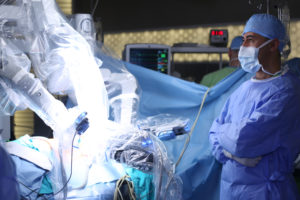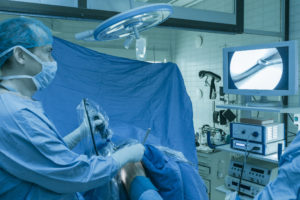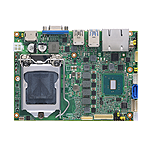Orthopedic Devices – The Future is Powered by Embedded Technology
 The orthopedics medical device industry landscape is changing with the utilization of
The orthopedics medical device industry landscape is changing with the utilization of
advanced computer technology. According to MPMN MedTech Pulse’s Top Orthopedic Firms and Trends from 2014 to 2020 report, advancements in nanotechnology, robotics, smart implants, and other technological innovations are expected to grow the orthopedic device market exponentially over the next few years. It’s an exciting time for all of us, especially for medical device integrators, engineers, physicians, and patients alike.
Trends in Orthopedic Surgery and Treatment
Technology has long been the major influence in shaping how complex medical procedures such as orthopedic surgeries are performed. Better medical devices are allowing medical professionals to look beyond what the eyes and endoscopic cameras can see. Surgeons now use specialized methodologies that arise from the usage of innovative medical equipment to look deeper inside patient’s surgical sites; to train and be trained; to plan and rehearse difficult procedures; and even to work alongside and to control a robotic surgical arm to provide the highest level of safety and precision and the least amount of errors. Advanced medical computer technology has become more available and accessible, allowing for improved diagnosis, procedures, treatment plans and patient survival rates.
Below are a few interesting examples of recent technology trends that are fueled by advanced orthopedic devices and systems that are changing the industry.
A. Augmented Reality:
While the phrase augmented reality might conjure up images of video games, medical device manufacturers are utilizing this technology to positively impact the healthcare industry. Using augmented reality, medical professionals can create scenarios for learning how to approach risky procedures and complex cases. Augmented reality is now being used for surgery preparation, navigation and training.
- For better surgical navigation — For example, orthopedic surgeons often use computer-assisted navigation systems such as computed tomography-based CT scans and imageless. These navigational systems can offer 2D – 3D imagery that allows for operations to be pre-planned, ensuring that the surgeon matches each step of the procedure with the guidance of the virtual reality system. It can allow for a real-time mode where the surgeon can clearly see the surgical area and can take the necessary course of action. The instrument movements and implants are led by the computer guidance system. However, these systems emit radiation, making it important for surgeons and others in the operating room to check on their own exposure over time.
- 3D fluoroscopy-based system captures markers placed on specific anatomical sites and offer independent CT scan-type views of selected areas and the instruments/implants without being affected by position changes. With 3D technology, the 2D images are converted into coronal, sagittal and axial reconstructions. This newer technology offers the benefits of better, selected visualization of various anatomical views in the surgical room without moving the patient.
- Imageless navigation system utilizes a computer, camera and infrared markers to specify affected areas. The computer processes the information, matching it to many referenced CT scans to construct a model that offers the virtual view of the selected areas. This system relies heavily on the surgeon’s expertise and precision in marking and plotting the areas. Its best advantage is that there is no radiation usage, hence, no exposure for the patient and the medical staff in the surgical room.
These navigation systems have become much more sophisticated with emerging technology that offers better imagery, faster processing time, faster or real-time responses and more accurate calculations for better precision. New and improved features and functionalities are being implemented on newer systems. Some navigational systems can provide surgeons with feedback that can help or even prevent actions during a surgery to ensure total safety. Knee arthroplasty surgery, for example, has become more successful due to the help of better computer technology. The procedure calls for a replacement of a patient’s knee with a prosthesis. Advanced navigation systems allow for better accuracy in knee/joint axis alignment, which is crucial to the long-term success of the total knee arthroplasty.
For Surgical Planning and Training — Orthopedic surgeons use various technologies such as robotic arms and simulations to plan and practice their surgeries in order to lower their error rates as well as improving their accuracy, safety and success rates. These simulations allow surgeons to use 3D models of bones and implants to determine the optimal procedural steps, precision of placement and accurate fixation of implants. Students can learn from robot-assisted, virtual training classroom from world-renowned doctors who do not have to be locally present. Skill sets required to successfully face difficult scenarios and risky procedures can be practiced with realistic virtual reality simulations. Pre-operational plans can be mapped accurately through virtual surgical systems, hence, allowing for less errors and faster surgical completion time – and further minimize deviation from surgical plans during actual procedures for safer and more effective results.
B. Remote Surgeries Using Robotic Arms:
 The use of robotic arms to perform surgery has become more prevalent and popular because of their improved accuracy and ability to perform complex and – otherwise, difficult for human surgeon, with better speed and precision. These systems use robotic arms to assist surgeons to remotely perform certain types of surgeries such as hip and knee replacements. The majority of these systems are placed inside the surgical room beside the surgeon. They typically consist of a vision system so surgeons can “see” what they are doing; a patient-side cart with robotic arms that mimic the movement of human hands to physically perform the surgery; and a console that the surgeon uses to control the movement of the arms as a tool to accomplish surgical tasks. For orthopedics, robotic-assisted surgical systems are becoming known for their improved reliability for safely performing unicompartmental knee arthroplasty (UKA) to replace arthritis damaged knee compartments and total knee arthroplasty (TKA). Robotic-assisted surgical systems have better control over important aspects of these surgeries such as lower leg alignment, soft tissue balance, joint line maintenance, as well as alignment, size and fixation of the tibial and femoral components. In short, these robotic arms can perform UKA and TKA surgeries with the highest precision, in the shortest amount of time and can ensure that each patient heals quickly with minimal pain.
The use of robotic arms to perform surgery has become more prevalent and popular because of their improved accuracy and ability to perform complex and – otherwise, difficult for human surgeon, with better speed and precision. These systems use robotic arms to assist surgeons to remotely perform certain types of surgeries such as hip and knee replacements. The majority of these systems are placed inside the surgical room beside the surgeon. They typically consist of a vision system so surgeons can “see” what they are doing; a patient-side cart with robotic arms that mimic the movement of human hands to physically perform the surgery; and a console that the surgeon uses to control the movement of the arms as a tool to accomplish surgical tasks. For orthopedics, robotic-assisted surgical systems are becoming known for their improved reliability for safely performing unicompartmental knee arthroplasty (UKA) to replace arthritis damaged knee compartments and total knee arthroplasty (TKA). Robotic-assisted surgical systems have better control over important aspects of these surgeries such as lower leg alignment, soft tissue balance, joint line maintenance, as well as alignment, size and fixation of the tibial and femoral components. In short, these robotic arms can perform UKA and TKA surgeries with the highest precision, in the shortest amount of time and can ensure that each patient heals quickly with minimal pain.
C. 3D Printing:
3D printers are becoming indispensable tools that can be used to quickly create prototypes of implants and 3D models of fractures and deformities. These anatomical models can be used in preplanning stages to help the surgeon with visualization by providing a complete view of a specific bone to help give the surgeon a closer and more detailed look at the problem and how it can be fixed. It’s also possible to 3D print a reverse image, or negative, to help the surgeon shape bone grafts during surgery. Furthermore, the practice of using metal 3D printed implants for a variety of different joints has been gaining major popularity because they can be manufactured to be patient-specific for a perfect fit within a patient. These 3D printed implants also boast a faster creation time as well as lower cost compared to other implant options.
Embedded Computer: The Major Technological Influencer in the World of Orthopedics
With the help of advanced computer hardware, computer-assisted navigation systems or computer-assisted orthopedic surgery systems have now made surgeries safer and faster while also providing faster recovery times for patients. More than the examples above of how technology can impact the future of orthopedic treatments, newer medical equipment and instruments will pave the way with better features and functionalities that will benefit all.
or computer-assisted orthopedic surgery systems have now made surgeries safer and faster while also providing faster recovery times for patients. More than the examples above of how technology can impact the future of orthopedic treatments, newer medical equipment and instruments will pave the way with better features and functionalities that will benefit all.
These systems can help surgeons perform orthopedic surgeries that include knee and hip arthroplasty, osteotomies, fracture treatment, shoulder surgery, spinal surgery and more. While augmented reality and robotic arms certainly have the “wow” factor, these futuristic medical marvels couldn’t exist without powerful computer hardware such as embedded motherboards, medical-grade touch panel PCs and embedded computers. Specifically, embedded motherboards and embedded controllers serve as the brains behind many of these orthopedic medical devices while medical-certified touch panel PCs can provide medical professionals with a user-friendly interface in a variety of medical applications.
Just as personal computers have become smarter, faster, and more capable than ever thanks to their inner workings, the same is true of the embedded controllers and motherboards found in medical device hardware. In order to power robotic-assisted surgery systems, fluoroscopic X-ray systems, complex 3D joint replacement simulation and beyond- these medical devices require advanced computer hardware technology.
As medical trends continue to improve, medical device manufacturers will need to integrate the latest software and the best industrial computer hardware to control all aspects of surgical navigational systems, robotic-assisted surgical systems, 3D printing, artificial joint manufacturing systems and more. The future of orthopedic surgery is looking bright with new technologies that will influence surgical success, long-term prognosis, patient’s longer life span and higher quality of post-surgery life.
Axiomtek’s Embedded Computer Products that have Helped Shape the World of Orthopedics
Axiomtek’s high performance embedded motherboards, medical panel PCs and embedded systems have been selected by many global medical device manufacturers for integration into their systems. Axiomtek’s embedded motherboards feature high performance CPUs, rich I/O options for expandability and come in a variety of form factors for various applications. They were integrated to run robotic surgery systems, surgical navigational systems and many other complex medical operations.
Axiomtek’s medical-grade touch panel PCs (MPCs) feature a range of high performance CPU options, full HD touchscreens with high graphical capabilities and user-friendly interfaces with variable screen sizes for medical applications such as robotic-assistant surgery patient-side carts, nursing cart interfaces and more. The MPC product series features UL60601-1/EN60601-1 medical certifications, high ingress rated front bezels for dust/liquid spillage protection, IPX1 antimicrobial enclosures for bacterial invasion prevention, and are made in the ISO-13485 certified environment to offer high reliability and product longevity to medical equipment manufacturers.
Axiomtek’s industrial-grade embedded systems are powerful, highly versatile and customizable and are designed to provide easy integration into a variety of medical hardware and software. The eBOX products are highly suitable for use as medical computers/controllers. The series offers a variety of scalable CPU options, great wireless communication options for data management and device-to-device communication and extensive expandability options. These systems are fanless, feature extended operating temperature ranges and high ingress protection ratings for reliable operation in a variety of medical environments including robotic arm controllers and more.
Product Showcase:
Feature-rich, Highly Customizable Industrial Embedded Motherboards
CAPA500 – Advanced Industrial-grade 3.5” Embedded Single Board Computer
- Scalable CPU options with 7th/6th Generation Intel® Core™ i7/i5/i3, Pentium® or Celeron® processors with Intel® H110/Q170 chipset
- Rich expandability options with one full-size PCIe Mini Card slot with mSATA support and one ZIO interface for add-on PCIe x1, COM port, USB 3.0 port, GbE or DIO modules
- Rich I/O options with dual Gigabit Ethernet ports, three USB 2.0 ports, three USB 3.0 ports, HD audio and one 8 channel DIO port
- Q170 chipset supports triple view display via HDMI, VGA, and LVDS
PICO500 – High Performance and Highly Customizable Pico-ITX Embedded Motherboard
- Scalable CPU options with 6th Generation Intel® Core™ i7/i5/i3 or Celeron® processors
- Integrated Intel® HD graphic engine supports HDMI and 18/24-bit dual channel LVDS that delivers Ultra HD 4K visual experiences
- Rich I/O options with flexible board-to-board connector which integrates an HD audio port, four USB 3.0 ports, one PCIe x1, one DDI, and two UARTs interfaces
- Easy maintenance with Intel® Active Management Technology (AMT) 11.0 on Intel® Core™ i7 and i5 for remote management
High Graphical Performance Medical-certified Touch Panel PCs
MPC153-834 – High Graphics Quality, Fanless Medical-grade Touch Panel PC
- High performance Intel® Celeron® J1900 quad-core processor with PCIe Mini Card slots for wireless communication and data transfer options
- EN60601-1/CE/FCC class B medical certifications with dust/liquid spillage-proof IP65-rated front bezel and IPX1 antimicrobial plastic enclosure
- 15.6” WXGA display with PCT or 5-wire flat resistive touch screen
- Flexible power options with wide voltage range of 100V – 240VAC-DC with 60W power adapter or optional 9V – 36VDC with terminal block
Easy-to-integrate and Highly Expandable Fanless Embedded Computer Systems
eBOX560-880-FL – Fanless and Feature-rich Embedded Computer System
- Scalable CPU options with Intel® Core™ i5 4300U (1.9 GHz), i3 5010U (2.1 GHz) or Celeron® 2980U (1.6 GHz) processors
- Delivers Ultra HD visual experiences with DualView via HDMI and DisplayPort
- Compact, palm-sized design for space constricting environments
- Operational stability with wide operating temperature range of -20°C to +50°C
Sources:
http://electronicdesign.com/embedded/these-trends-will-shape-embedded-technology-2017
http://ieeexplore.ieee.org/document/7328061/?reload=true&arnumber=7328061
https://wwwcg.in.tum.de/?id=1894
http://www.nature.com/articles/srep17081
https://www.hindawi.com/journals/ijta/2015/576364/
https://www.quora.com/How-and-why-are-embedded-systems-in-health-care-units-used
http://www.medicalimageanalysisjournal.com/article/S1361-8415(16)30113-X/fulltext
http://www.healio.com/orthopedics/journals/ortho/2013-8-36-8/%7Bbe950756-3f4b-4717-80ab-c13ce3b64893%7D/computer-assisted-navigation-in-orthopedic-surgery
http://www.mdedge.com/amjorthopedics/article/108342/robotics/robotic-assisted-knee-arthroplasty-overview
http://www.odtmag.com/contents/view_online-exclusives/2015-09-11/a-bright-future-for-3-d-printing-in-orthopedics





